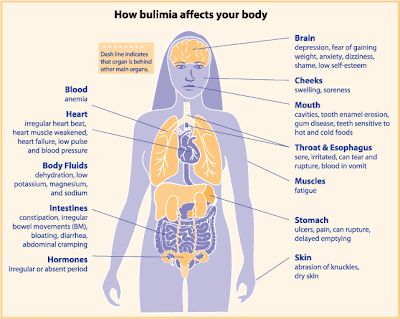
Les TCA: un mal-être spécifique des jeunes de notre époque?
mercredi 26 janvier 2011
L'apparence.
L'apparence peut être perçue de plusieurs façons:
On a 2 images de nos corps:
- un représentation visuelle
- construction synésthetique
- construction synésthetique
Les deux images s'opposent complètement l'une à l'autre, ce qui crée un malaise.
Le corps est notre partenaire le plus fidèle, il est là pour toute notre vie donc il ne faut pas qu'on en abuse. Il faut qu'on prenne soin de notre corps.
Il ne faut pas oublier qu'on ne peut pas s'aimer si on aime pas notre corps.
Bulimia.
Bulimia, more than any other mental disorder, affects more than 90% of women, some people even say 99%.
Also whats striking is that the disorder occurs more frequently in the middle and upper classes. In the female population the age group is between 18 and 35 years old and about 2.5% of cases bulimia.
The incidence of bulimia has increased significantly in recent years, it is often used to explain the existing lack of the ideal slim figure. There are about 4 / 5 of all patients diagnosed before 22, the age in which half of those cases of bulimia are preceded by anorexia.
Since 1980, bulimia has been developed and considered an independent diagnosis.
It is expected that alternate in the course of the disease phases with low and very pronounced symptoms.
On average, there is a problem already existing 5 years before the first treatment is attempted. This is partly due to the fact that patients often try to conceal their illness and make arrangements so that they will not be discovered by others.
After an inpatient therapy about 40% of the patients improved significantly and are referred to as 20% partially improved. The remaining 40% but remains in a treatment success. This seems to be particularly the case in women who are suffering in addition to bulimia and depressive symptoms or anxiety disorders.
En 2006, en France 50,000 de personnes souffrent d'anorexie...
"Le monde des Ados"
En île-de-France, on dénombre 180 000 cas d'anorexie chez les femmes et 19000 chez les hommes
"Le monde"
Les troubles alimentaires toucheraient 20%des adolescentes.
"Le monde"
La boulimie touche 1 à 2 jeunes filles sur 10.
"Le monde"

Comment peut-on définir ces troubles?
Qu’est-ce que l’anorexie ?
L’anorexie mentale est définie par un poids insuffisant, par l’arrêt des règles, par une crainte de grossir ou de reprendre du poids et puis surtout un trouble de l’image corporelle : la jeune fille étant très maigre se voit très grosse. Le déni massif de la maladie est également un symptôme de l’anorexie. Contrairement à la boulimie, il n’y a pas ce sentiment de culpabilité, l’anorexie renforce le patient, le rend tout puissant notamment chez les jeunes filles qui avaient du mal à trouver une identité, ou une place dans la famille ou ailleurs : tout d’un coup c’est comme un statut. Etre anorexique mentale, c’est une sorte d’identité pour certaines, une façon de vivre, presque une vision philosophique du corps !


Et la boulimie ?
La boulimie nerveuse est accompagnée ou pas de vomissement. Elle se définit comme l’ingestion rapide et massive de grandes quantités d’aliments jusqu’à l’écœurement, jusqu’au malaise suivi de culpabilité. Ces crises viennent soulager un état de tension interne qui est insupportable pour la personne. La plupart des boulimiques ont un poids normal car elles adoptent des stratégies de compensation qui peuvent être des vomissements, des utilisations de laxatifs, de diurétiques, une activité physique excessive ou l’alternance de crises de boulimie avec des phases de restriction alimentaire, de jeun, pendant plusieurs jours. Et puis celles qui n’adoptent pas de stratégies d’adaptation, de compensations face à ça prennent forcément du poids. La boulimie est vécue comme quelque chose d’humiliant, de dégradant.
Source:
Effects of bulimia
The most dangerous side effect of bulimia is dehydration due to purging. Vomiting, laxatives, and diuretics can cause electrolyte imbalances in the body, most commonly in the form of low potassium levels.

Physical consequences
- heartburn
- tooth decay and gum damage
- cracks in the wall of the stomach or esphagus
- too low blood pressure
- circulatory problems
- giddiness,fatigue,palpitations,sweating,vision problems,fainting
- muscle cramps,muscle weakness,constipation,kidney damage,fluid accumulation
- burns of the pharynx end esophagus
Psychological consequences
- mood swings
- depressions
- social isolation
- listlessness
- restlessness
- lack of concentration
- suicidal thoughts
 Teeth after frequent vomiting^ ^
Teeth after frequent vomiting^ ^ In patients with bulimia it comes in that is held between the binge eating diet or the fact that the food is broken, in the meantime to malnutrition. As a consequence of hormonal and metabolic changes occur, through which the energy consumption is reduced.
Under these conditions, a normal calorie intake leads to a short-term weight gain, with the result that patients increasingly try to control their weight. In this way, could not normalize the biological changes and it uses a vicious circle.
On the psychological level can be observed that the disturbed eating behavior often results in the victims to withdraw from other people and lose interest in other things. This isolation can exacerbate the lack of self-esteem, often suffer from the bulimic women.
Just try this deficiency but women make up the fact that they reach through weight control, a supposedly more attractive appearance.

The weight loss has profound psychological consequences. Changes in protein metabolism (amino acids, building blocks of proteins or proteins) can low-carbohydrate diet may be at the transmission between nerve cells change in the brain (by serotonin deficiency) and thus change the mood. With increasing depression patients lose more and more joy and interest in the environment. Simultaneously, the concentration does lose as well as the overall performance and also the interest in sex.
Inscription à :
Articles (Atom)

